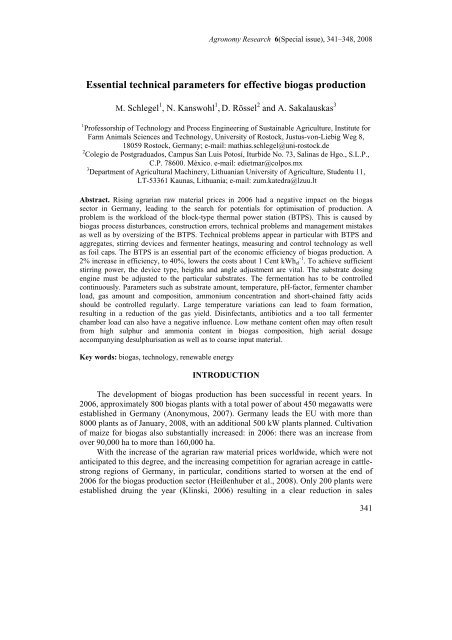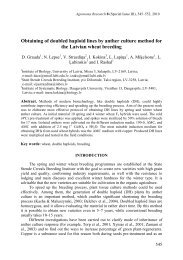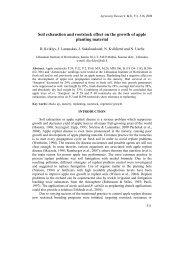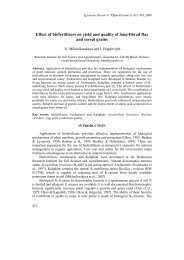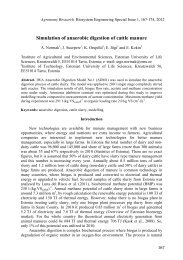Essential technical parameters for effective biogas production
Essential technical parameters for effective biogas production
Essential technical parameters for effective biogas production
Create successful ePaper yourself
Turn your PDF publications into a flip-book with our unique Google optimized e-Paper software.
<strong>Essential</strong> <strong>technical</strong> <strong>parameters</strong> <strong>for</strong> <strong>effective</strong> <strong>biogas</strong> <strong>production</strong><br />
M. Schlegel 1 , N. Kanswohl 1 , D. Rössel 2 and A. Sakalauskas 3<br />
1 Professorship of Technology and Process Engineering of Sustainable Agriculture, Institute <strong>for</strong><br />
Farm Animals Sciences and Technology, University of Rostock, Justus-von-Liebig Weg 8,<br />
18059 Rostock, Germany; e-mail: mathias.schlegel@uni-rostock.de<br />
2 Colegio de Postgraduados, Campus San Luis Potosí, Iturbide No. 73, Salinas de Hgo., S.L.P.,<br />
C.P. 78600. México. e-mail: edietmar@colpos.mx<br />
3 Department of Agricultural Machinery, Lithuanian University of Agriculture, Studentu 11,<br />
LT-53361 Kaunas, Lithuania; e-mail: zum.katedra@lzuu.lt<br />
Abstract. Rising agrarian raw material prices in 2006 had a negative impact on the <strong>biogas</strong><br />
sector in Germany, leading to the search <strong>for</strong> potentials <strong>for</strong> optimisation of <strong>production</strong>. A<br />
problem is the workload of the block-type thermal power station (BTPS). This is caused by<br />
<strong>biogas</strong> process disturbances, construction errors, <strong>technical</strong> problems and management mistakes<br />
as well as by oversizing of the BTPS. Technical problems appear in particular with BTPS and<br />
aggregates, stirring devices and fermenter heatings, measuring and control technology as well<br />
as foil caps. The BTPS is an essential part of the economic efficiency of <strong>biogas</strong> <strong>production</strong>. A<br />
2% increase in efficiency, to 40%, lowers the costs about 1 Cent kWhel -1 . To achieve sufficient<br />
stirring power, the device type, heights and angle adjustment are vital. The substrate dosing<br />
engine must be adjusted to the particular substrates. The fermentation has to be controlled<br />
continuously. Parameters such as substrate amount, temperature, pH-factor, fermenter chamber<br />
load, gas amount and composition, ammonium concentration and short-chained fatty acids<br />
should be controlled regularly. Large temperature variations can lead to foam <strong>for</strong>mation,<br />
resulting in a reduction of the gas yield. Disinfectants, antibiotics and a too tall fermenter<br />
chamber load can also have a negative influence. Low methane content often may often result<br />
from high sulphur and ammonia content in <strong>biogas</strong> composition, high aerial dosage<br />
accompanying desulphurisation as well as to coarse input material.<br />
Key words: <strong>biogas</strong>, technology, renewable energy<br />
Agronomy Research 6(Special issue), 341–348, 2008<br />
INTRODUCTION<br />
The development of <strong>biogas</strong> <strong>production</strong> has been successful in recent years. In<br />
2006, approximately 800 <strong>biogas</strong> plants with a total power of about 450 megawatts were<br />
established in Germany (Anonymous, 2007). Germany leads the EU with more than<br />
8000 plants as of January, 2008, with an additional 500 kW plants planned. Cultivation<br />
of maize <strong>for</strong> <strong>biogas</strong> also substantially increased: in 2006: there was an increase from<br />
over 90,000 ha to more than 160,000 ha.<br />
With the increase of the agrarian raw material prices worldwide, which were not<br />
anticipated to this degree, and the increasing competition <strong>for</strong> agrarian acreage in cattlestrong<br />
regions of Germany, in particular, conditions started to worsen at the end of<br />
2006 <strong>for</strong> the <strong>biogas</strong> <strong>production</strong> sector (Heißenhuber et al., 2008). Only 200 plants were<br />
established druing the year (Klinski, 2006) resulting in a clear reduction in sales<br />
341
volume (about 50%) of the <strong>biogas</strong> plants manufacturers registered in 2007. The causes<br />
lie in the strong increase of the prices of the input material from especially tilled<br />
renewable raw materials which led to a deterioration of the economic efficiency of<br />
<strong>biogas</strong> <strong>production</strong>.The results create uncertainty <strong>for</strong> farmers as well as those planning<br />
<strong>biogas</strong> plants. The legislature is being asked to create dependable basic conditions <strong>for</strong><br />
the <strong>biogas</strong> plant manufacturers and plant operators <strong>for</strong> the short, medium and long<br />
term. The changing situation should be used by <strong>biogas</strong> plant operators (farmers) as an<br />
occasion to determine optimisation potentials in <strong>biogas</strong> <strong>production</strong> that will increase<br />
efficiency. Many <strong>biogas</strong> plants are operating at a suboptimal level; there is a great need<br />
<strong>for</strong> optimisation of operations (Neumann, 2007).<br />
342<br />
Economic efficiency depends on plant technology<br />
Economic efficiency of a <strong>biogas</strong> plant depends upon its operational safety. High<br />
quality plant components and their integration into the total process are a condition <strong>for</strong><br />
economic success. Significant <strong>technical</strong> problems occur in particular in the following<br />
per<strong>for</strong>med plant technology:<br />
− block-type thermal power stations including adjoining aggregates,<br />
− stirring devices (agitators) and fermenter heatings,<br />
− measuring and control technology, and<br />
− foil caps.<br />
Fig. 1. Block-type thermal power station.<br />
Block-type thermal power stations (Fig. 1): A significant problem is maintaining<br />
a full workload. In many block-type thermal power stations producing <strong>biogas</strong>, the<br />
middle workload amounts to only 5500 to 6000 full load hours per year: 8000 hours<br />
per year represents optimal efficiency (Schlegel et al., 2007). So the engines should<br />
have good efficiency <strong>for</strong> the partial load (Krautkremer, 2007). Poor efficiency results
from down-times caused by massive process disturbances, mistakes in plant<br />
construction, <strong>technical</strong> problems and management mistakes as well as by over-sizing of<br />
the block-type thermal power stations. The efficiency of the block-type thermal power<br />
station-engine plays an essential role in the economic efficiency of <strong>biogas</strong> <strong>production</strong><br />
(Fig. 2).<br />
Fig. 2. Sensitivity of a block-type thermal power station with 500 kWel and use<br />
of <strong>biogas</strong> from renewable materials (Hofmann et al., 2005).<br />
An improvement of about two percentage points on 40% would lower the cost<br />
prices of electric current about 1 Cent kWhel -1 . On the contrary, lowering efficiency by<br />
about 2 percentage points would raise the cost prices of electric current by 1.2 Cent<br />
kWhel -1 Deteriorating efficiency has greater consequences than improvement because<br />
of the exponential curve course. The engines are also susceptible to major disturbances<br />
or damages if the oil change intervals are too long, variations of the quality and amount<br />
of gas, or the engine overheats due to faulty chilling circulations. Poor quality or the<br />
acidification of the engine oil can lead directly to engine troubles. A regular analysis of<br />
the oil quality as well as the constant control and servicing of the technology including<br />
the chill circulations is extremely important.<br />
Stirring devices (Figs 3 and 4) and fermenter heatings (Fig. 5): Stirring devices in<br />
<strong>biogas</strong> plants should not only prevent swimming and settling layers or contribute to<br />
their resolution, but also mix fresh and fermented substrate. In addition, the mixing<br />
activity in the fermenter should achieve a steady temperature. The gas in the fermenter<br />
chamber should be prepared <strong>for</strong> escaping by mixing. Contingent on the application of<br />
plant material, a relatively low energy concentration of the whole ration with a high<br />
portion of hardly fermentable substances arises (Mumme et al., 2007). If the dry<br />
substance content of the substrate is too high in the fermenter, insufficient functioning<br />
of the stirring device in the fermenter chamber can leave a residue of gas in the<br />
chamber, which can extend and block security armatures and gas lines. In extreme<br />
343
cases, the fermenter could burst. A common fermentation of energy plants with<br />
economic fertilizers turns out to be advantageous <strong>for</strong> several reasons. The liquefaction<br />
effect of the fertilizers during the mixing process lowers costs (Hopfner-Sixt et al.,<br />
2007).<br />
If the installed stirring device power is too low, mixing times are extended and<br />
increase current consumption. Also important are the slow-running stirring device with<br />
long shaft (Fig. 3) or diving-engine (Fig. 4) stirring devices, the heights and angle<br />
setting, the type, quality and dry substance content of the used substrates. Frequent<br />
damages in stirring devices are caused by the penetration of humidity into the engine<br />
space of the diving-engine stirring devices. A strong layer <strong>for</strong>mation in the fermenter<br />
can cause higher resistance. This can lead to a fracture in the propellor or to a bending<br />
of the shaft. Corrosion can cause other damages in the bearings. Damages can be<br />
reduced as the operator manages the substrate composition, as well as by planning the<br />
size of the fermenter, type of the substrate, <strong>for</strong>m, position and corresponding power of<br />
the stirring devices.<br />
Fig. 3. Stirring device with long shaft<br />
(slow).<br />
344<br />
Fig. 4. Stirring device with diving-engine<br />
(faster).<br />
Fig. 5. Fermenter heating tubes.
Substrate dosing engine: Aside from the composition of the substrate mixture,<br />
substrate conditioning has the potential to optimize <strong>production</strong> efficiency of the entire<br />
plant (Scholwin et al, 2004).<br />
The substrate dosing engine should be tuned optimally to the used substrates to<br />
reach a good milling, particularly of fiber-rich material. Inadequate tuning can result in<br />
bridge <strong>for</strong>mations and blockages which can lead to disturbances of the dosage<br />
Continuous laboratory analysis of the substrate can often recognise changes in the<br />
process and the operator can intervene quickly. The costs <strong>for</strong> the analyses are minimal<br />
compared to those of a plant malfunction.<br />
Measuring and control technology: To achieve successful practice of a <strong>biogas</strong><br />
plant in the long term, the fermenting process must be continuously controlled so that<br />
the active micro-organism groups in the fermenter find good environmental conditions<br />
and a balance <strong>for</strong>ms in the fermenter. Only few plants are satisfactorily equipped with<br />
measuring technology <strong>for</strong> supervision of the process. But <strong>parameters</strong> such as mass of<br />
supplied substrates, fermenting temperature (Fig. 6), pH factor, dwell time, space load,<br />
<strong>biogas</strong> amount and composition, ammonium concentration and short-chained fatty<br />
acids should be controlled regularly. If the dwell time of the substrate in the fermenter<br />
is too short, methane bacteria can leach because of methane’s longer generation time.<br />
As a result of this process the dismantling speed diminishes (Grepmeier, 2002).Thus<br />
disturbances can be recognised in the fermentation process and countermeasures can be<br />
initiated. In addition, the kinds, time and frequency of the substrate input can be<br />
recorded. If a substrate dosing engine exists, the engine can weigh the substrate. If<br />
liquid components are supplied to the fermenter, the capture of this biomass occurs<br />
with the flow measuring instruments which work electronically.<br />
Fig. 6. Temperature detector.<br />
Fig. 7. Flash protection at the foil<br />
cap.<br />
Foil caps: During the operation gas mixtures capable of explosion exist in the gas<br />
space of the fermenting chamber. Sparking is to be avoided. The stirring device should<br />
be worked beneath the surface. Additionally, a flash protection device (Fig.7) should<br />
be installed close to the foil cap.<br />
345
346<br />
Certified staff is necessary <strong>for</strong> reacting to disturbances and interruptions<br />
The complexity of the process of the <strong>biogas</strong> <strong>production</strong> requires certified staff.<br />
There<strong>for</strong>e, training, as well as the exchange of experience with other <strong>biogas</strong> operators<br />
is a must. Certified staff is most important during the start-up phase but may be<br />
necessary thereafter, as well.<br />
The staff must react to some disturbances in the fermenting process, the causes <strong>for</strong><br />
which are varied. Wide variations of temperature and pH-value influence the activity<br />
of the bacteria leading to process disturbances, e.g. foam <strong>for</strong>mation, which can reduce<br />
gas yield up to 30%. However, foam <strong>for</strong>mation can be also caused by too much fat and<br />
protein: trans<strong>for</strong>mation of the substrates is influenced substantially by the proteinenergy<br />
relationship. The whole energy of protein-rich substrates cannot be used<br />
(Öchsner, 2006). In this context the regular entry of micro-organisms which are<br />
involved in the fermenting process causes a stabilisation of this process by increasing<br />
the buffer capacity. This is essential <strong>for</strong> the neutralisation of acids <strong>for</strong>med during the<br />
fermenting process (Karpenstein-Machan, 2005).<br />
Low gas yield can have many causes: If the gas yield is too low, the causes can lie<br />
in the concentrated impact of disinfectants, antibiotics and in an excessive fermenter<br />
chamber load. Also possible, an insuffucient dry substance content in the liquid manure<br />
and congested gas lines. Low methane content, a common occurrence, frequently<br />
traces back to too much sulphur or ammonia content and excessive aerial dosage<br />
during the desulphurisation. Input of grain that is too coarse can also increase the<br />
oxygen entry and decrease the methane content. If the input substrates are processed or<br />
chopped up faultily, the result can be not only a lower gas yield but also a higher<br />
oxygen entry into the fermenter. If the pH-factor drops too strongly, the problem may<br />
lie with the substrate supply or the overstressing of the fermenter chamber load,<br />
resulting in an increase of the organic acids, decrease of the pH-value and a<br />
disturbance of the biochemical balance. There<strong>for</strong>e, steady filling of the fermenter and a<br />
well-balanced nutrient composition in the substrate (among other things C/N - relation)<br />
should be constant.<br />
Chemical pre-treatments of the substrates with different procedures can have a<br />
positive effect on the specific methane yield. With input material rich in cellulose, the<br />
hydrolysis velocity has an important impact on the whole fermenting velocity;<br />
breaking up the cellulose be<strong>for</strong>e the fermentation can make sense (Kaltschmitt &<br />
Hartmann, 2000). If the <strong>biogas</strong> processing is disturbed by high contents of hydrogen<br />
sulphide, the cause is the application by substrates with high protein contents and non-<br />
functioning desulphurisation of the <strong>biogas</strong>. It can result in corrosion damages in the<br />
technology or as irregular operation of the engine. A change of the substrate<br />
composition as well as the application of iron salts and active coal filter can improve<br />
the situation.<br />
Another problem is the <strong>for</strong>mation of sinking layers which can result from the<br />
application of e.g. chicken manure and biological rubbish which are not mixed with<br />
sufficient intensity. If the heavy materials (e.g. sand) are already drawn off in the dump<br />
and the stirring device works with frequent relatively short mixing intervals, this<br />
problem can normally be minimised. Swimming layers often appear with the use of<br />
substrates with high dry substance contents, e.g. litter manure and silage. Too low
mixing intensity in the fermenter is another cause. A reduction of dry substance content<br />
of less than 12% and frequent short mixing intervals af<strong>for</strong>d remedial action.<br />
Other optimisation potentials exist in improving the energy efficiency by creation<br />
and rein<strong>for</strong>cing of possibilities <strong>for</strong> reusing the rejected heat. Additional options include<br />
the breeding of plants which are rich in yield, the involvement of alternative plants, as<br />
well as the optimisation of cultivation procedures including the appropriate crop<br />
rotation systems.<br />
CONCLUSIONS<br />
After a number of highly successful years the <strong>biogas</strong> sector is currently facing<br />
challenges. High raw material prices in the agricultural sector negatively affect the<br />
economic efficiency of the <strong>biogas</strong> plants, and draught is a factor. Economic<br />
optimisation of a permanently successful <strong>biogas</strong> plant operation, especially one which<br />
combines farming and <strong>biogas</strong> <strong>production</strong>, requires both technological and farm<br />
management skills.<br />
The following conditions are recommended <strong>for</strong> an economically efficient and<br />
technologically sound <strong>biogas</strong> operation:<br />
1) Choosing suitable technology, with expert and regular servicing<br />
2) Knowledge about and careful selection of substrates<br />
3) Adaptation to specific plant conditions<br />
4) Exact monitoring and recording of the process to allow <strong>for</strong> adjustmnent and<br />
intervention in a timely manner when necessary<br />
5) Attention to improved nutrient composition by coordinating the choice, method<br />
of preparation and dosage of substrates<br />
6) Expedient use of rejected heat<br />
These measures have the potential to improve energy efficiency despite increased<br />
prices of raw materials and can make an important contribution to stabilising economic<br />
efficiency, as well.<br />
REFERENCES<br />
Anonymous. 2007. Biogasboom gebremst. In: Profi Magazin für professionelle Agrartechnik.<br />
Landwirtschaftsverlag, Münster, 12/07.<br />
Hofmann, F., Plättner, A., Lulies, S. & Scholwin, F. 2005. Evaluierung der Möglichkeiten zur...<br />
Klinski, S. 2006. Einspeisung von Biogas in das Erdgasnetz. Project Report of Fachagentur<br />
Nachwachsende Rohstoffe e.V. Institut für Energetik und Umwelt gGmbH Leipzig u.a.<br />
199 pp.<br />
Grepmeier, M. 2002. Prozesssteuerung und - optimierung durch Gasanalyse an Biogasanlagen.<br />
In: Erneuerbare Energie in der Landwirtschaft 2002/2003. Zeven, Verlag für<br />
landwirtschaft-liche Publikationen, pp. 75–81.<br />
Hopfner-Sixt, K., Amon, T., Bauer, A., Kryvoruchko, V., Amon, B. Bodiroza, V., Ramusch,<br />
M., Hrbek, R., Friedel, J. K., Boxberger, J. & Zollitsch, W. 2007. Möglichkeiten zur<br />
Verbesserung der Gasausbeute aus Gärrohstoffen. In: http://energytech.at,<br />
Bundeministerium für Verkehr, Innovation und Technologie Austria, 14.12.2007.<br />
Heißenhuber, A., Berenz, S. & Rauh, S. 2008. Food Production contra Energy Production. In:<br />
Agricultural Engineering 20, DLG Verlag, Frankfurt am Main, 15–21.<br />
347
Kaltschmitt, M. & Hartmann, H. 2001. Energie aus Biomasse: Grundlagen, Technik und<br />
Verfahren. Springer Verlag Berlin, Heidelberg, New York, 770 pp.<br />
Neuman, H. 2007. Jede zweite Biogasanlage hat Defizite. In: top agrar, Landwirtschaftsverlag,<br />
Münster, 103–105.<br />
Schlegel, M.; Ludley, H.; Kanswohl, N.; Orth, M. & Schmidt, K. 2007. Optimierungspotenziale<br />
bei der Biogaserzeugung und –verwertung in Mecklenburg Vorpommern. In: Proceedings<br />
of 1. Rostocker Bioenergie<strong>for</strong>um. Band 5. pp. 171–179.<br />
Karpenstein-Machan, M. 2005. Energiepflanzen für Biogasanlagenbetreiber. 1. Auflage.<br />
Frankfurt a. M. DLG Verlag.<br />
Krautkremer, B. 2007. Verdienen mit System. In: joule-Agrarenergie, Technik, Politik,<br />
Wirtschaft. Deutscher Landwirtschaftsverlag, München, pp. 42–45.<br />
Mumme, J., Linke, B. & Heiermann, M. 2007. Solid state anarobic digestion of renewable<br />
biomass sources – state of research and development. In: Bornimer Agrartechnische<br />
Berichte Heft 61, Potsdam-Bornim, pp. 100–106.<br />
Öchsner, H. 2006. Biogaspotentiale bei der Vergärung von Nachwachsenden Rohstoffen. In:<br />
Internationaler Workshop Biogas „Bioenergie aus Biogasanlagen: Status und<br />
Perspektiven“, 23.3.2006 in Husum, Deutschland.<br />
Scholwin, F., Weidele, T., Gattermann, H., Schattauer, A. & Weiland, P. 2004.<br />
Anlagentechnikund Biogasbereitstellung. In: Handreichung Biogasgewinnung und –<br />
nutzung. Report Fachagentur Nachwachsende Rohstoffe e.V., Gülzow.<br />
348


